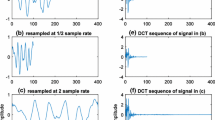Abstract
Watermarks are hidden, imperceptible, and robust marks augmented into a host signal such as audio or video. Recent studies show that in the presence of an adversary, “blind” watermark detection within an attacked clip is an exceptionally difficult task. In this paper, we explore two technologies, beat detection and block redundant coding, to combat de-synchronization and watermark estimation as two attacks that have demonstrated superior effectiveness in preventing watermark detectors from reliably accomplishing their goal. As a result, we have achieved robustness of spread-spectrum watermarks augmented in audio clips to almost arbitrary constant time-warp, pitch-bending, and wow-and- flutter of up to 1%. The adversary can remove the watermark by subtracting an estimate of the watermark from the signal with an amplitude in excess of 6dB with respect to the host. Such an attack vector typically affects substantially the fidelity of the “pirated” recording.
Access this chapter
Tax calculation will be finalised at checkout
Purchases are for personal use only
Preview
Unable to display preview. Download preview PDF.
Similar content being viewed by others
References
Anderson, R. J., Petitcolas, F.A.P.: On the limits of steganography. Journal on Selected Areas in Communications, vol.16, pp.474–481, IEEE (1998). 161
Bassia, P., Pitas, I.: Robust audio watermarking in the time domain. EUSIPCO, vol.1. Rodos, Greece, IEEE (1998). 161
Boneh D., Shaw J.: Collusion secure fingerprinting for digital data. Transactions on Information Theory, vol.44, pp.1897–1905, IEEE (1998). 163
Chen, B., Wornell, G. W.: Digital watermarking and Information embedding using dither modulation. Workshop on Multimedia Signal Processing, Redondo Beach, CA, IEEE (1998). 161
Cox, I. J., Kilian, J., Leighton, T., Shamoon, T.: A secure, robust watermark for multimedia. Information Hiding Workshop, Cambridge, UK, (1996). 161, 164
Dempster A.P., Laird N.M., Rubin D.B.: Maximum Likelihood from Incomplete Data via the EM Algorithm. Journal of the Royal Statistical Society, vol.39, no.1, pp.1–38, (1977). 162
Gruhl, D., Lu, A., Bender, W.: Echo hiding. Information Hiding Workshop, Cambridge, UK, (1996). 161
Haitsma J. A., Kalker T., Oostveen J.: Robust Audio Hashing for Content Identification. International Workshop on Content Based Multimedia and Indexing, Brescia, Italy, 2001. 163
Hartung, F., Su, J.K., Girod, B.: Spread spectrum watermarking: malicious attacks and counter-attacks. Security and Watermarking of Multimedia Contents, San Jose, CA, SPIE (1999).
Jessop P.: The Business Case for Audio Watermarking. IEEE International Conference on Acoustics, Speech and Signal Processing, vol.4, pp.2077–2080, Phoenix, AZ, (1999). 162
Katzenbeisser S., Petitcolas, F.A.P., (eds.): Information Hiding Techniques for Steganography and Digital Watermarking. Artech House, Boston (2000). 161
Kirovski D., Malvar H.: Robust Covert Communication over a Public Audio Channel Using Spread Spectrum. Information Hiding Workshop, Pittsburgh, PA, (2001). 161, 162, 165, 167, 170, 171, 172
Kirovski D., Malvar H.: Robust Spread-Spectrum Audio Watermarking. IEEE International Conference on Acoustics, Speech, and Signal Processing, Salt Lake City, UT, IEEE (2001). 165
Kirovski D., Malvar H., Yacobi Y.: A Dual Watermarking and Fingerprinting System. Microsoft Research Technical Report, (2001). 160, 161, 163, 174
Kirovski D., Malvar H.: Embedding and Detecting Spread Spectrum Watermarks under The Estimation Attack. International Conference on Acoustics, Speech, and Signal Processing, Orlando, FL, IEEE (2002). 161, 174, 175
Linnartz, J. P., van Dijk, M.: Analysis of the sensitivity attack against electronic watermarks in images. Information Hiding Workshop, Portland, OR, (1998). 161
Malvar H.: A modulated complex lapped transform and its application to audio processing. International Conference on Acoustics, Speech, and Signal Processing, Phoenix, AZ, IEEE (1999). 165
Malvar, H. S.: Auditory masking in audio compression. Greennebaum, K. (ed.): Audio Anecdotes. Kluwer, New York, (2001). 165
Neubauer, C., Herre, J.: Digital watermarking and its influence on audio quality. 105th Convention, San Francisco, CA. Audio En-gineering Society (1998). 161, 165
Su, J. K., Girod, B.: Power-spectrum condition for energy-efficient watermarking. International Conference on Image Processing, Yokohama, Japan, IEEE (1999).
Swanson, M. D., Zhu, B., Tewfik, A. H., Boney, L.: Robust audio watermarking using perceptual masking. Signal Processing, vol.66, pp.337–355, (1998). 161, 164, 165
Szepanski, W.: A signal theoretic method for creating forgery-proof documents for automatic verification. In: Carnahan Conf. on Crime Countermeasures, Lexington, KY, pp.101–109, (1979). 161, 164
van Trees, H. L.: Detection, Estimation, and Modulation Theory. Part I, New York: John Wiley and Sons, (1968). 164
Author information
Authors and Affiliations
Editor information
Editors and Affiliations
Rights and permissions
Copyright information
© 2003 Springer-Verlag Berlin Heidelberg
About this paper
Cite this paper
Kirovski, D., Attias, H. (2003). Audio Watermark Robustness to Desynchronization via Beat Detection. In: Petitcolas, F.A.P. (eds) Information Hiding. IH 2002. Lecture Notes in Computer Science, vol 2578. Springer, Berlin, Heidelberg. https://doi.org/10.1007/3-540-36415-3_11
Download citation
DOI: https://doi.org/10.1007/3-540-36415-3_11
Published:
Publisher Name: Springer, Berlin, Heidelberg
Print ISBN: 978-3-540-00421-9
Online ISBN: 978-3-540-36415-3
eBook Packages: Springer Book Archive




